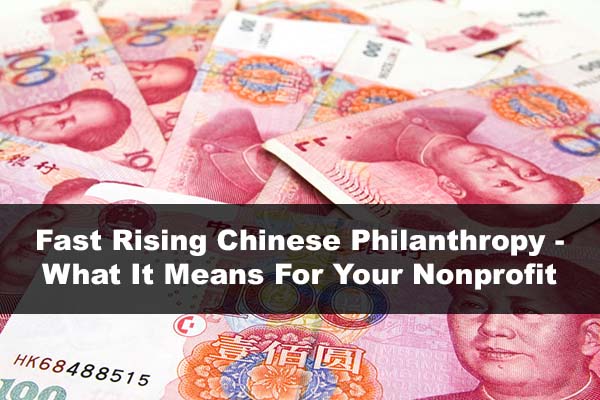China has overtaken the US in number of the world’s wealthiest at a rapid pace. In 2018, Forbes reported 2,208 billionaires in the world. 819 are Chinese; 571 are American. China had 122 billionaires on the 2013 list. There are 5.7 times as many super wealthy people in the country only 5 years later. There were no Chinese billionaires before 2000. (See sources below.)
What is interesting, however, is not the mimicry of capitalist structures and super wealth between China and the US in the new Millennium, but the mimicry of philanthropy. Philanthropy, by Chinese in China or Chinese living abroad, was virtually nonexistent before 2000.
A United Nations Development Programme Report in 2015 showed a 66% increase in charitable donations between 2009 and 2014 alone.
There were no Chinese private foundations before 2005. In 2017 there were 3,980. Giving increased 12 fold over that time, and China now has a ‘charity law’ to encourage nonprofit formation and giving. (See Nonprofit Quarterly for more information.)
What are the causes of these boosts in Chinese philanthropy? What are the main trends in the phenomenon? And how does it relate back to your nonprofit?
The drivers of Chinese philanthropy
– Some argue that the entire concept of philanthropy is American in origin and tied to entrepreneurism and a fear of taxation for social programs. Others argue that giving has deeper ties to communities’ perceptions of each other’s moral obligations, based on religious or philosophical contexts.
– Lu, Rios and Huang published in a 2015 Rutgers University research report that the preexisting religious and philosophical pretexts of Confucianism, Taoism, and Buddhism in China are likely the main driver of increased philanthropy in the new Millennium. All three contribute to ideas of sharing collective capital for the greater good, as well as linkages of morality to humaneness.
– The reality is that for any philanthropy to exist, wealth must first exist. Then what must exist is need within a community. While China always had need, it now has wealth. It is likely not a coincidence that the quick rise in billionaires has correlated so closely to the quick rise in philanthropy. Wealth predicates giving when the state does not have mechanisms to support those in need.
– Another condition is example. Many Chinese philanthropists, in interviews, claim that they first learned about philanthropy from a great American philanthropist. Often that philanthropist had a profound impact on them perfectly. And the concept of giving did not occur to them before that experience.
Zhang Xin, worth more than $3 billion, reported to the New York Times that she never dreamed she would become a philanthropist until she received a study abroad scholarship that changed her life. Bill Gates inspired one of China’s wealthiest, Jack Ma Yun (Alibaba), to be a philanthropist through his philanthropy promotion initiatives in country.
Globalization, with wealthy external actors doing business in China, and millions of Chinese leaving country to study and work abroad, has coupled with wealth and need to create magical growth in giving.
Also read: What your nonprofit can learn from global philanthropy trends
What are the main trends in Chinese giving?
In just 12 months, from May 2017 to May 2018, 76 Chinese donors gave more than $5 million to charitable causes.
It is probably no surprise that a good portion of Chinese giving is based in the United States. Chinese and Chinese-Americans that have studied abroad and stayed in the States are now giving billions of dollars to nonprofits and universities.
Major gifts by Chinese-Americans increased 5-fold from 2008 to 2014, to near $500 million. Also, Chinese that do business with American companies are giving at the largest levels ever.
Two examples include:
- Brothers Gerald and Ronnie Chan from Hong Kong gave the largest gift in Harvard University’s history of $350 million.
- Tianqiao Chen and Chrissy Luo’s $115 million to Caltech for a Neuroscience center. Chen and Luo, based in Singapore, are Chinese nationals with holdings in a number of American-based companies. This was their first gift Stateside.
What is even more incredible is that China has a huge philanthropy gap, second to worst in the world (see CAF for more information).
Only .17% of the China GDP goes to philanthropy (compared to 2% of US GDP). The Borgen Report claims that China is uncharitable because of perceptions of corruption and a poor legal environment, to date, to promote charity. These trends are both reversing, however, with pro-charity legislation passed in 2017 and 2018 and the government actively promoting transparency and frameworks for giving.
9 Ways to use Nonprofit Watchdogs’ standards to up your game
What that means is that China’s philanthropy potential is most likely going to burst in coming years, extending billions in new funding for projects in China and across the world, especially in places where Chinese live and do business.
What does Chinese philanthropy mean for your nonprofit?
We can learn from this example and apply it to nonprofit work everywhere, especially in 3 key ways:
- Look to where wealth is for your donor pool, but focus on people that are grateful. Those that have received scholarships or were impacted by philanthropy in their own lives are likely to become philanthropists, no matter what their heritage or culture.
- Focus on your program work to attract donors. The nonprofits and universities that are solving the deepest of our global problems, no matter where they are, attract the biggest gifts. Though you may not be able to compete with CalTech or Harvard, you can strive to be the best in your particular nonprofit field, no matter how big or small. The donors follow!
- Be an example. Show how your work is connecting us all, in a globalized world, to each other. Humaneness, no matter what religion or philosophical pretext underwrites a culture, speaks for itself and can attract new people to your cause.

